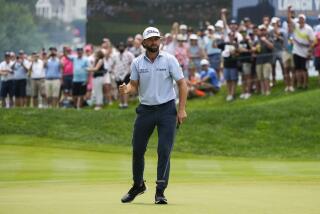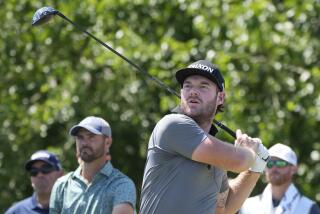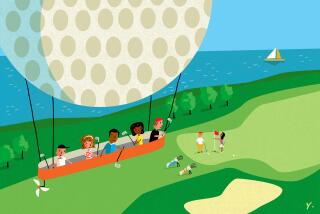Golfâs Bottom Rung
It is not yet midday at Soboba Springs Country Club and already the sun is working overtime. For those hearty souls who golf in 112-degree heat like this, there is more to be concerned about than just making birdies. They also must worry whether the sand in the bunkers is going to melt while theyâre standing in it or if the bottoms of their shoes will suddenly catch fire as they walk down the fairways.
The nearby San Jacinto Mountains glow in the heat, silently soaking it all in. Back in the 1920s and â30s, Soboba Springs was a popular Riverside County resort, where the health-conscious would come to soak in the natural spring water. Eucalyptus, oleander, palms and Italian cypress accent a green, cultivated golf course that today seems oddly out of place in surroundings where most other vegetation is the color of gravy.
Meanwhile, out on the course, the predominant hues are the shades of red on the faces of four dozen or so golfers who are trying to cheat sunstroke, huffing and puffing through 18 holes of what would be called torture if it wasnât already called golf.
What theyâre really doing is chasing a dream. And they believe it starts here. They want to make golfâs big time, the PGA Tour, where players such as Tiger Woods make millions, courtesy cars wait, somebody else cleans their spikes and clubs, the food is free, the golf courses perfect and the prize money . . . well, itâs pretty much off the charts compared to what theyâre making now.
And so in the stifling late summer heat, playing in virtual anonymity in a tournament where the total prize money is their own entry fees, with nothing guaranteed except a car trip to another tournament in another town, these professional golfers do what they do best. They survive.
Welcome to golfâs minor league, otherwise known as the mini-tour. If there is a ladder to the big leagues of the PGA Tour, the mini-tour is its lowest rung. The golfers who play this circuit may have loops in their swing, yips in their putts and duck-hooks off the tee, but thatâs not the whole picture.
They also have perseverance, a love for the game and a dream theyâve latched on to and just wonât give up. At least not without a fight.
Steve Justice, 30, from Corona del Mar, looks as though heâd be equally at home on a surfboard or a golf course. But Justice is what youâd call a lifer, supporting his mini-tour habit by working part-time as a bartender in Newport Beach.
After he forks over a $320 entry fee at Soboba Springs, his financial resources are sort of limited. In fact, he doesnât have any. But hey, whatâs money? Itâs only useful when it can pay for golf.
Justice sounds like a lovesick teenager: âItâs my passion, my life, my love, my dream to make the PGA Tour. I love the game so much, itâs so hard sometimes, I feel like my insides are cracking. Iâd rather be miserable playing golf than happy doing anything else.â
*
An estimated 5,000 pro golfers are on the road playing mini-tour golf, many competing in upward of 60 events a year. At least there are plenty of opportunities to work, with as many as 15 mini-tours nationwide, from Florida to California, from Washington to Texas. Southern Californiaâs primary mini-tour is the Golden State Tour, consisting mainly of two- and three-day events, such as this tournament at Soboba Springs.
Some of these tours have sponsors, usually in the golf equipment business, which increases the prize money at stake. But Golden State has no sponsor dollars behind it, so the players wind up playing for their own money.
âItâs organized gambling,â says John Flannery, who played on the PGA Tour in 1993 and 1994 and is now back on the mini-tour.
Mike Sugar, a mini-tour regular, says this isnât exactly a good place to get rich: âNo, itâs a good place to get poor. Iâm not in it for the money. Thatâs not the reward or the goal. Itâs getting my chance.â
The Golden State Tour was begun as an eight-event series in 1982 by Doug Ives, then a Long Beach Press-Telegram sportswriter. Ivesâ tour now runs 100 professional tournaments a year with 1,000 players, about 400 of them pros. Golden State events cover a lot of territory, from Lompoc to San Diego to the desert inland. Thatâs why Ives is in Soboba Springs, trying to beat the heat just like everyone else. He may be more successful at that than trying to find sponsors to pump more money into his mini-tour.
The current marketing strategy of golf equipment manufacturers is to spend their endorsement dollars on proven stars where the exposure is great. Flannery, for one, understands. âWhat exposure do you get out here?â he asks.
Out here in the broiling sun, the big-time tour shimmers in the distance like some kind of mirage. There are only 125 players who can play full-time on the PGA Tour and the same number on the lesser Nike Tour, which is characterized by smaller purses and tournaments played in places you often canât find without a map.
There is also one more added aggravation: How you get on board. The nastiest two words in golf . . . qualifying school. Players with the best 40 scores get PGA Tour playing privileges for one year. The next 70 can play the Nike Tour. The rest can pack up their cars for the mini-tours. Those who try Q School consider it the most humiliating, pressurized, gut-wrenching, mind-bending experience in golf. But itâs also what just about every one of the 5,000 or so mini-tour players want to do . . . either that or have their caddie run over them in a golf cart.
Until then, the mini-tour players show up, trying to hang on by the tips of their fingernails. Theyâre waiting it out, hoping something will happen to them as it did to one of their brethren--Tom Lehman. The 1996 British Open champion, Lehman is the most famous of the mini-tour alums, who also include PGA Tour players John Daly, Paul Goydos, Woody Austin, Michael Bradley, Guy Boros, Loren Roberts, Larry Nelson, Mark McCumber, Scott McCarron, Steve Lowery, Nolan Henke, Dudley Hart and Neal Lancaster. Besides playing on the mini-tours, every player on this list has something else in common: Each went on to win at least one tournament on the PGA Tour.
And so life goes on every week on mini-tours like the Golden State, where every time a player tees up his ball, he has one thought in mind.
âThe Golden State,â says Ives, âis a place everyone wants to be from.â
*
At soboba springs, there are as many PGA Tour wannabes as cacti along the main road.
* Steve Justice, who graduated from El Toro High School, didnât even pick up a golf club until his senior year. Since then, he has hardly put one down.
He went to Arizona State for one year, decided he was allergic to studying, then caddied on the LPGA Tour for a while before trying the mini-tours. Justice works three nights a week as a bartender mixing highballs, but doesnât like it. Heâd rather be hitting golf balls. As for his personal life, oatmeal is more exciting. Heâs single and doesnât have a girlfriend, basically because he canât find anyone who wants to support his habit.
For him, itâs just golf and worrying about how to stay afloat financially. âIâm grinding my guts out,â Justice says. âThe stress level is so incredible. Sometimes I stand over a putt and I think, âIf I donât make this I canât make my car payment.â I know I have an ulcer.â
So why keep beating your head against the wall?
âI need a lot more playing time to tell myself I canât make it,â he says. âI havenât even begun to fight. . . I wake up every morning thinking about what tournament Iâm going to play. OK, I donât have any money. No savings account, no checking account, nothing. Thatâs how I live. Iâm not proud of it, thatâs just the way it is. I would never in a million years trade what Iâve learned, just to see what life is like when you live it like I have.â
* Mike Sugar is in his second reincarnation as an athlete. He used to swing at balls with seams, not dimples, as a third baseman for UC Irvine. The 32-year-old from Anaheim Hills handled a shovel in his father Frankâs landscaping business in Lawndale before being bitten by the mini-tour bug.
Sugar even made it up a step on the golf ladder in 1994 when he played the Nike Tour, but his greatest success has come on the mini-tours. He has thrown his clubs into the winnerâs circle 15 times, one of them the 1996 Queen Mary Open in Long Beach. It hasnât made him wealthy, though.
In 1995, Sugar was the leading money winner on the Golden State Tour with $40,000. He estimated his expenses for the year at $25,000.
âIf you know how to live on $15,000 a year, well, I sure donât,â he says. âThis is not about money. I know what itâs like to have a real job. Itâs not that I didnât enjoy work. But Iâd wake up every day and my heart wasnât in it. I was going through the motions.â
* Kevin Riley wakes up every day and goes through the emotions. The 26-year-old from El Cajon played golf at San Diego State and decided to make a career of it. He isnât sorry--yet.
Riley got married in May. His wife is a student, so heâs the primary breadwinner, even if he does it hitting golf balls with practically nobody watching on out-of-the-way courses, playing for his own money.
To economize, he tries to limit himself to $20 hotel rooms and to keep his meal expenses at $10 to $12 a day. Last year, a friend sponsored Riley, but he isnât around any longer. This just added to his stress level, Riley says:
âYouâd be lying to say you werenât concerned about the money.â
*
* John Flannery, 35, is a teaching pro at the Golf Center in Palm Desert. The former USC golfer with the jet-black hair and easy grin is trying to keep his game sharp until qualifying school later this fall. He won four times on the Nike Tour and played well enough in 1993 to win $161,234 on the PGA Tour. That put him No. 102 on the money list and meant he kept his PGA Tour card for 1994. But he didnât fare as well--$94,105--and finished No. 159, which cost him his playing privileges for 1995.
Now heâs on the mini-tour, and Flannery knows from experience how far it is from the Big Show: âIâve been there and back.â
âI donât know how they do it out here,â he says. âEverybodyâs trying to make the Nike Tour, but itâs few and far between who do. Thereâs a long way to go for guys playing mini-tours. But itâs so hard to walk away from, too. Itâs a great game. You get that itch to play, that competitive fire. Itâs like a drug.â
* Joe Acosta Jr. was 14 and living in Visalia when he knew he wanted to be a professional golfer. A two-time California junior champion and a second-team All American at Fresno State in 1993 and 1994, he earned his PGA Tour card for 1995 at the dreaded Q School.
He won $147,745 and kept his PGA Tour card, then hooked his career out of bounds. Acosta missed the cut 18 times in 1996, won just $37,632 in 30 tournaments and lost his PGA Tour playing privileges for this year.
Until he gets another crack at the PGA Tour, the 23-year-old Acosta knows one thing. If he doesnât make it, you wonât find him playing the mini-tour circuit once he reaches 30.
âYouâre over 30 and youâre still here, youâre running out of time,â Acosta says. âLook in the mirror and think about it . . . âWhat am I doing?â Youâre losing a lot of brain cells out here.â
*
Tt must be the heat. Golf balls seem to be acting the most sensibly out here, jumping into the holes to get out of the sun. Maybe it wonât be so hot in San Diego. Maybe there will be some cloud cover in Long Beach. Maybe the next mini-tour events will be a lot different. They will be rich in prize money, the field will be small, the chance to strike it rich will be big. Maybe when qualifying school comes around, someone will just hand out cards to play the PGA Tour next year.
Or maybe not.
But, hey, a guy can hope, canât he? Justice has got a perfect scenario worked out in his mind and heâs just waiting for it to happen: âThe golf gods will come down out of the sky and strike our putters and bless us.â
Or maybe not.
The grass on the Soboba Springs Country Club fairways is starting to look like someone just removed it from the microwave. Sweaty players drop their bags near the table in front of the locker room and post their scores.
Everyone had a late start today because the pros had to wait for the menâs club to finish its round first. Yes, as if the conditions werenât tough enough, thereâs nothing like a few dozen spikes making Swiss cheese out of the greens before you try to win back your $320 entry fee.
In the end, the 40 players totaled up the scores. Only 16 would divide the money. Flannery, who won the tournament, earned $2,500. Acosta made $920, Sugar $700 and Riley $650.
Justice came away with nothing. You can bet heâs miserably happy.
More to Read
Go beyond the scoreboard
Get the latest on L.A.'s teams in the daily Sports Report newsletter.
You may occasionally receive promotional content from the Los Angeles Times.










